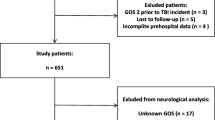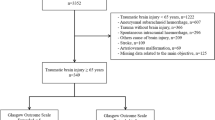Summary
Background
Traumatic brain injury (TBI) is a leading cause of death and disability worldwide. Many prognostic models predicting mortality in patients with TBI were developed, which also include patients with mild or moderate TBI and patients who suffered major extracranial injuries.
Methods
From a prospective database, we conducted a retrospective medical chart review covering the period between January 2000 and December 2012 of patients with isolated severe TBI (Abbreviated Injury Score for head, AISH ≥ 3) without extracranial injuries, who were intubated in the field using the rapid sequence intubation method and were of age 16 or more. Prehospital vital signs, Injury Severity Score (ISS) and laboratory tests were compared in two study groups: survivors (n = 25) and non-survivors (n = 27). Selected variables identified during univariate analysis (p < 0.1) were then subjected to multivariate analysis logistic regression model.
Results
Univariate analysis showed that in-hospital mortality was statistically significantly associated with male sex (p = 0.040), ISS (p = 0.005) and mydriasis (p = 0.012). For predicting mortality, area under the curve (AUC) was calculated: for ISS 0.76 (95 % confidence interval, CI; 0.63–0.90; p < 0.001) and for initial Glasgow Coma Scale (GCS) 0.64 (95 % CI, 0.49–0.80, p = 0.079). In the multivariate analysis, ISS (odds ratio, OR; 1.19, 95 % CI, 1.06–1.35; p = 0.004) and mydriasis (OR, 5.73; 95 % CI, 1.06–30.88; p = 0.042) were identified as independent risk factors for in-hospital mortality. The AUC for the regression model was 0.83 (95 % CI, 0.71–0.94; p < 0.001).
Conclusions
In prehospital intubated patients with isolated severe TBI only ISS and mydriasis were found to be independent predictors of in-hospital mortality.



Similar content being viewed by others
References
Hyder AA, Wunderlich CA, Puvanachandra P, Gururai G, Kobusingye OC. The impact of traumatic brain injury: a global perspective. NeuroRehabilitation. 2007;22:341–53.
Utomo WK, Gabbe BJ, Simpson PM, et al. Predictors of in-hospital mortality and 6 month functional outcomes in older adults after moderate to severe traumatic brain injury. Injury. 2009;40(9):973–7.
MRC CRASH Trial Collaborators, Perel P, Arango M, Clayton T, et al. Predicting outcome after traumatic brain injury: practical prognostic models based on large cohort of international patients. BMJ. 2008;336(7641):425–9.
Boto GR, Gomez PA, De L, Cruz J, et al. Severe head injury and the risk of early death. J Neurol Neurosurg Psychiatry. 2006;77(9):1054–9.
Signorini DF, Andrews PJ, Jones PA, et al. Predicting survival using simple clinical variables: a case study in traumatic brain injury. J Neurol Neurosurg Psychiatry. 1999;66(1):20–5.
Steyerberg EW, Mushkudiani N, Perel P, et al. Predicting outcome after traumatic brain injury: development and international validation of prognostic scores based on admission characteristics. PLoS Med. 2008;5(8):e165.
Jacobs B, Beems T, van der Vliet TM, et al. Outcome prediction in moderate and severe traumatic brain injury: a focus on computed tomography variables. Neurocrit Care. 2013;19(1):79–89.
Mosenthal AC, Lavery RF, Addis M, et al. Isolated traumatic brain injury: age is an independent predictor of mortality and early outcome. J Trauma. 2002;52(5):907–11.
Tuma M, El-Menyar A, Abdelrahman H, et al. Prehospital intubation in patients with isolated severe traumatic brain injury: a 4 year observational study. Crit Care Res Pract. 2014:135986. doi:10.1155/2014/135986.
Leitgeb J, Mauritz W, Brazinova A, et al. Effects of gender on outcome after traumatic brain injury. J Trauma. 2011;71(6):1620–6.
Bukur M, Kurtovic S, Berry C, et al. Pre-hospital intubation is associated with increased mortality after traumatic brain injury. J Surg Res. 2011;170(1):e117–21.
Murray JA, Demetriades D, Berne TV, et al. Prehospital intubation in patients with severe head injury. J Trauma. 2000;49(6):1065–70.
Davis DP, Peay J, Sise MJ, et al. The impact of prehospital intubation on outcome in moderate to severe traumatic brain injury. J Trauma. 2005;58(5):933–9.
Wang HE, Peitzman AB, Cassidy LD, et al. Out-of-hospital endotracheal intubation and outcome after traumatic brain injury. Ann Emerg Med. 2004;44(5):439–50.
Eckstein M, Chan L, Schneir A, et al. Effect of prehospital advanced life support on outcomes of major trauma patients. J Trauma. 2000;48(4):643–8.
Ley EJ, Short SS, Liou DZ, et al. Gender impacts mortality after traumatic brain injury in teenagers. J Trauma Acute Care Surg. 2013;75(4):682–6.
Kraus JF, Peek-Asa C, McArthur D. The independent effect of gender on outcomes following traumatic brain injury: a preliminary investigation. Neurosurg Focus. 2000;8(1):e5.
Ottochian M, Salim A, Berry C, et al. Severe traumatic brain injury: is there a difference in mortality? Am J Surg. 2009;197(2):155–8.
Author information
Authors and Affiliations
Corresponding author
Ethics declarations
Conflict of interest
M. Strnad, V. Borovnik Lesjak, V. Vujanović, and M. Križmarić declare that there is no conflict of interest regarding the publication of this paper.
Rights and permissions
About this article
Cite this article
Strnad, M., Borovnik Lesjak, V., Vujanović, V. et al. Predictors of mortality in patients with isolated severe traumatic brain injury. Wien Klin Wochenschr 129, 110–114 (2017). https://doi.org/10.1007/s00508-016-0974-0
Received:
Accepted:
Published:
Issue Date:
DOI: https://doi.org/10.1007/s00508-016-0974-0




